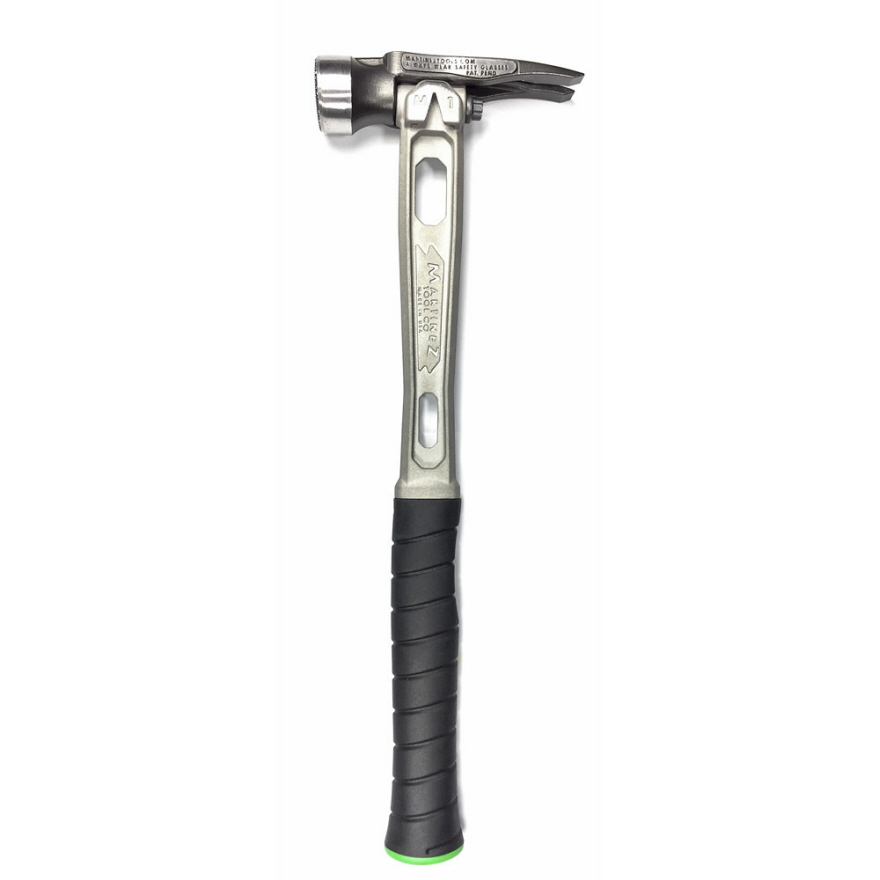
Martinez Tool Company's Modular Hammer
From the inventor of the all-titanium hammer—a system for quickly swapping steel heads on wood and titanium handles.
Even the most extreme tool nuts can be forgiven for not having heard of Mark Martinez; I'd never heard of the guy until I was introduced to him a few weeks back at The World of Concrete in Las Vegas. A carpenter by trade, Martinez invented the solid titanium framing hammer in the late 1990s and produced it under the Stiletto Tools label until the brand was acquired by Milwaukee.
That hammer was significant not just for its use of titanium, but for beginning the trend towards lighter hammers—with framing models now as light as 12 or 14 ounces. The idea took awhile to catch on with carpenters because it was completely at odds with the traditional rule of thumb referred to in a Core77 story about Estwing's new steel/aluminum hammer:
Traditionally framers used 22- to 28-ounce hammers to produce the requisite driving power, and paid the price with repetitive motion injuries to their arms and shoulders. The current thinking is that lighter is more ergonomic, which is where E=1/2MV² comes in. In classic mechanics, kinetic energy (which for hammers equates to driving force) for non-rotating objects is equal to 1/2 mass (the weight of the head) times velocity (speed of the swing) squared. Simply put, swing faster and you can generate the same nail driving force with a lighter hammer.
Physics are just part of it; the other part has to do with materials. According to Martinez, titanium absorbs shock as well and won't break when used for a handle. But it can't take a beating, which is why the Martinez Tool Company makes steel-head hammers with wood or titanium handles.
 Martinez Hammer with Axe Handle
Martinez Hammer with Axe Handle Martinez Hammer with titanium handle
Martinez Hammer with titanium handleSteel is harder than titanium; a steel face stands up better to pounding nails and steel claws are less likely to break when used for prying or chopping (as is done during demolition work). And steel is heavier than titanium, so using it for the head puts the weight where it needs to be.
The heads on Martinez hammers are easily detached from the handles, allowing carpenters to use the same head with straight and axe-style wooden handles or the same titanium handle with smooth- and mill-faced heads. If something breaks or becomes worn it can be replaced in the field—including the rubber grips on titanium handles.
 Enter a caption (optional)
Enter a caption (optional) Enter a caption (optional)
Enter a caption (optional)On wood handle models, the head is held in place with a hardened screw that extends into the handle and threads through a captured metal piece.
On titanium handle models, the head is friction fit over wings on the handle and held in place by a bolt.
Martinez hammers are a premium product aimed at professional users, and given their price ($75 wood; $199 titanium) are not the kind of tool you keep in the junk drawer in the kitchen. They are available with milled or smooth faces and a ball peen head is said to be in the works.
-
oFavorite This
-
Q5Comment
K
{Welcome
Create a Core77 Account
Already have an account? Sign In
By creating a Core77 account you confirm that you accept the Terms of Use
K
Reset Password
Please enter your email and we will send an email to reset your password.


Comments
As a career carpenter with 25+ years in the trades I've used the same axe style 14oz American Stiletto head for well over 10 years. And absolutely love it. The transition from the indestructible 24oz steel Estwig was definitely worth every wooden handle I've replaced over the years. As with any tool you learn to do things a little different to compensate for the advantages versus the disadvantages. The constant ring of the steel that goes from the hand to the shoulder definitely did its damage to the wrist elbow and shoulder. Along with the added weight of the steel. My biggest regret was not owning one sooner. I prefer the wood over the all metal frame mainly to eliminate the vibration. That's purely preferential I'm sure others prefer the metal frame.
I wonder if there's any evidence supporting benefits of titanium. I spent a few minutes googling for reviews and objective comparisons, but virtually every superior performance assertion that I found was just a repeat of Stiletto's marketing claims.
I'm currently using for review the wood handle and titanium handle. I've been using the Tibone since 2002-3 and going back to wood is a noticeable difference. I can feel the vibration. If you take a titanium hammer and strike concrete and do the same with wood handle, you'll definitely notice the difference.
Most of what I know about this is annecdotal--what I've heard from carpenters who use a Stiletto Tibone and claim it does not transfer shock to their arms. There is some evidence that titanium (Ti) damps vibration more than most steel alloys, though frankly, I think this has as much to do with the shape/configuration of the hammer that is made from it as from the material itself. As for the material itself, see table VII of this doc from University of Texas Engineering Dept: http://tinyurl.com/zp9zqvo This would be a particular alloy--it's impossible to know exactly what's in the titanium used by Stiletto.
I love the cross-dowel attachment on the wood handle.